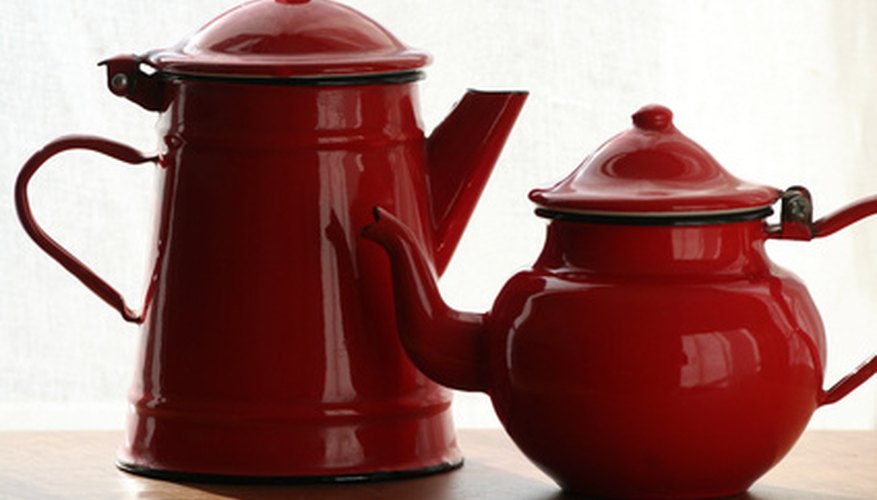Enamel-coated cookware is prized for its durability, attractiveness and ability to distribute heat evenly. Common enamel cookware includes Dutch ovens, grill pans and casserole dishes. Though most high-quality enamelware will last a lifetime, inexpensive, abused or faulty pieces can chip. Vitreous enamel is a coating of glass fused to metal at temperatures above 538 degrees Celsius, so a true repair must be done by a professional. However, there are a few tricks to fix chipped enamel cookware at home; these temporary solutions will provide a cosmetic solution to external chips or make an item with a cooking-surface chip safe for food.
- Enamel-coated cookware is prized for its durability, attractiveness and ability to distribute heat evenly.
- Vitreous enamel is a coating of glass fused to metal at temperatures above 538 degrees Celsius, so a true repair must be done by a professional.
Remove any loose enamel by using a hammer to lightly tap a chisel around the edge of the chip. This step is only necessary if you see visibly flaking or chipping material.
Dip a piece of steel wool into oil and scrub the edges of the chip in a circular motion. Apply firm pressure; the oil will lubricate the steel wool, making it easier and faster to clean. This step removes any tiny enamel pieces from the cookware.
Clean and thoroughly dry the cookware using a cotton rag and dish soap. If your chipped cookware base is not cast iron (such as aluminium or stainless steel) or if the chip is on the outside of your dish, proceed to Step 7.
Rub a light coat of oil on any exposed cast iron that is on the interior cooking surface of the piece.
- Dip a piece of steel wool into oil and scrub the edges of the chip in a circular motion.
- Rub a light coat of oil on any exposed cast iron that is on the interior cooking surface of the piece.
Place a sheet of aluminium foil on the bottom rack of your oven. Preheat the oven to 177 to 260 degrees Celsius.
Place the oiled enamelware facedown on the top oven rack. Bake for 1 hour, then remove and allow to fully cool. This is called "seasoning," and it will create a non-stick, food-safe surface on which you can continue to cook. Reseason as necessary to prevent rust from forming.
Apply a thin coat of enamel paint to any chip that will not come into contact with food. The paint is not true enamel---it merely resembles it---and is not food-safe. There are many colours available, so choose one that most closely matches your cookware. After it dries, apply additional coats as needed.
- Place the oiled enamelware facedown on the top oven rack.
- Apply a thin coat of enamel paint to any chip that will not come into contact with food.
TIP
Check with your cookware manufacturer before attempting any home repairs; some offer extended or even lifetime warranties and will replace damaged or defective pieces. Never cool a hot enamelled pan with cold water: The drastic change in temperature causes the enamel molecules to rapidly contract and can result in additional chipping. For permanent repairs or aesthetic fixes on the interior surface of your cookware, contact a professional enameller.
